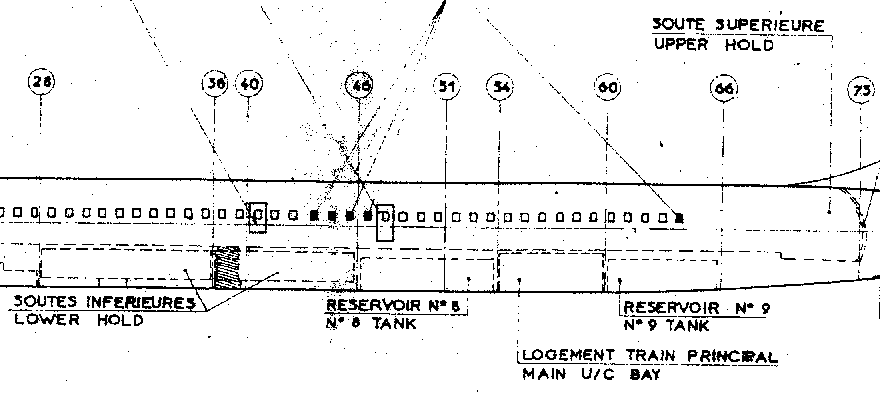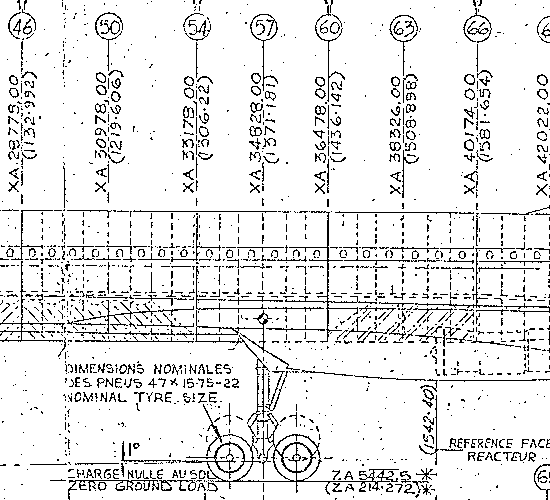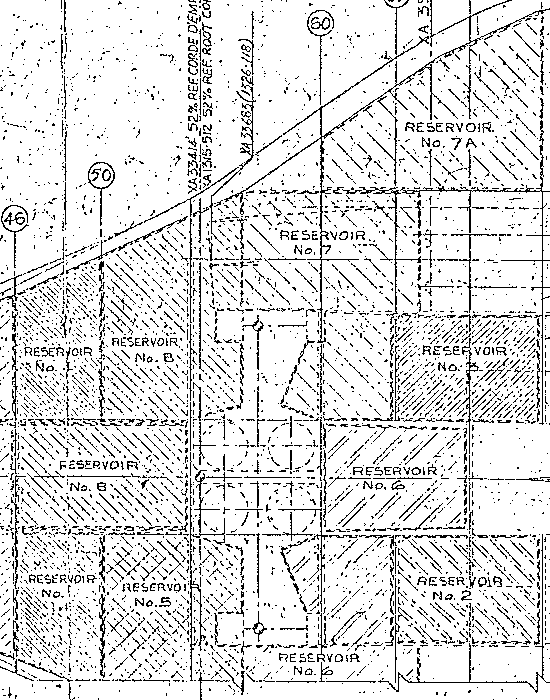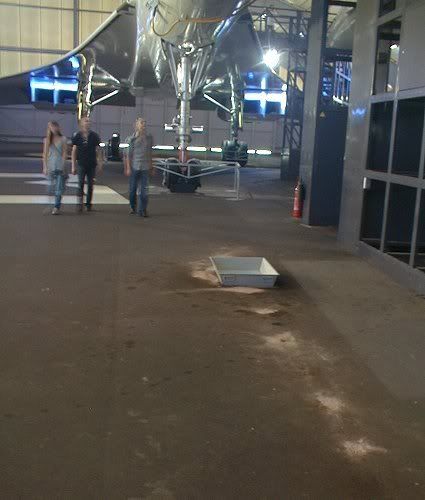October 28, 2010, 15:26:00 GMT
permalink Post: 6022968
Here are the drawings that should help with your last photo of Concorde "0001".
Not very good quality, since they're scans of xerox copies of xerox copies of microfilm ...
Prototype drawing dated July 1965, which in particular shows the location of the emergency exits.

Production drawing (two cut-outs from the same drawing at the same scale) which (schematically) does actually show the 'sloped areas' both at the front and the rear of the main landing gear bay.


Note 1 : both frame 54 and frame 60 were 'production breaks'.
Note 2 : the tanks were numbered differently on the prototypes ; tank N\xb0 9 on the prototype became tank n\xb0 6 on the production aircraft.
CJ
Subjects
Landing Gear
Links are to this post in the relevant subject page so that this post can be seen in context.
Reply to this quoting this original post. You need to be logged in. Not available on closed threads.
October 29, 2010, 16:31:00 GMT
permalink Post: 6025434
You're right, it was the Me163 that was rocket-powered using a hydrazine-based fuel.
I think the "Me162" in the early post was a simple typo, or an unintentional confusion with either the Me262 or the He162.
jodeliste ,
The original design was indeed by Bristol Aero Engines, which then became Bristol Siddeley. But the latter was taken over by Rolls Royce in 1966, so by the time Concorde first flew, it already had become a Rolls Royce engine.
CJ
Subjects
Bristol Siddeley
Rolls Royce
Links are to this post in the relevant subject page so that this post can be seen in context.
Reply to this quoting this original post. You need to be logged in. Not available on closed threads.
October 29, 2010, 18:01:00 GMT
permalink Post: 6025638
As mentioned earlier, hydrazine was "tamed" enough in the postwar years to make its use for EPUs in the military feasible (such as the F-16), where the weight gain is more important than the difficulties of handling the stuff.
Even so, just as well it was never used on the in-service Concordes... it's not the kind of product you want around on a civilian airport....
Just imagine a Concorde at the gate.. everybody being cleared away in a wide radius... a few people driving up with goggles, helmets and asbestos suits...
"What IS going on ??" "Oh, nothing, just topping up the APU"....
jodeliste ,
I have Stanley Hooker's book too. If you ever find that tape, put me on the distribution list for the DVD (all costs reimbursed, of course!).
CJ
Subjects
APU (Auxiliary Power Unit)
Hydrazine
Links are to this post in the relevant subject page so that this post can be seen in context.
Reply to this quoting this original post. You need to be logged in. Not available on closed threads.
October 29, 2010, 21:51:00 GMT
permalink Post: 6026121
But yes, "we were there", and, as far as I'm concerned, it's a true pleasure to have this thread where we all can share our bits of the story.
Glad you're enjoying it too !!
CJ
Subjects: None
No recorded likes for this post (could be before pprune supported 'likes').Reply to this quoting this original post. You need to be logged in. Not available on closed threads.
October 30, 2010, 14:54:00 GMT
permalink Post: 6027442
That question already ended up in a separate TechLog thread... LOL.
Concorde engine intake "Thrust"
Have a look there first, then if things still aren't quite clear, feel free to ask more questions!
CJ
Subjects
Intakes
Links are to this post in the relevant subject page so that this post can be seen in context.
Reply to this quoting this original post. You need to be logged in. Not available on closed threads.
November 02, 2010, 21:56:00 GMT
permalink Post: 6034473
I know this will sadden you... but better forewarned than discovering it on the day, no?
When they set up the Barbados 'Concorde Experience' on G-BOAE, they decided it would work far better if people could move one way, from the back to the front, rather than continuously getting in each others way.
Now, the two little service doors in the rear galley are not really suited as entrances for the public.
You should know!
Hence the decision was made to remove the rear galley (which they undoubtely kept in storage somewhere, if not actually on display) and to have people enter through the rear baggage hold door, through the baggage hold, and from there into the rear cabin.
(Much the same was done on Delta Golf, the Concorde now at the Brooklands, Weybridge museum.)
So, the only galley tops will be those in the forward galley. Snif....
CJ
Subjects
Barbados
Brooklands
Cabin Crew
G-BBDG
G-BOAE
Galley
Links are to this post in the relevant subject page so that this post can be seen in context.
Reply to this quoting this original post. You need to be logged in. Not available on closed threads.
November 06, 2010, 00:21:00 GMT
permalink Post: 6042279
But I agree, post after post has either an interesting question or an interesting answer!
With such a manually flown aircraft it would seem to be a natural for such an aid.
AFAIK , even today, only very few commercial aircraft types have HUDs installed.
SFENA (the firm I worked for) did work on a very limited HUD, basically just for runway alignment during take-off and roll-out, and IIRC some were installed on early A300s and A310s, but the idea never really seems to have caught on.
CJ
Subjects
HUD (Head Up Display)
Links are to this post in the relevant subject page so that this post can be seen in context.
Reply to this quoting this original post. You need to be logged in. Not available on closed threads.
November 06, 2010, 16:16:00 GMT
permalink Post: 6043590
Just Googled this to confirm a less-than-certain memory.....
Today, only the 737 (later variants) has a HUD fitted.
Not sure if it's a standard fit, or a customer option.
CJ
PS : off-topic, but the Mercure was a nice aircraft, even rarer than Concorde (incl. the prototypes only 12 built).
One is at the LBG museum, looking immaculate, and being kept "alive" by volunteers, but of course out of hours.
Subjects
HUD (Head Up Display)
Links are to this post in the relevant subject page so that this post can be seen in context.
Reply to this quoting this original post. You need to be logged in. Not available on closed threads.
November 06, 2010, 18:04:00 GMT
permalink Post: 6043746
Subjects
HUD (Head Up Display)
Links are to this post in the relevant subject page so that this post can be seen in context.
Reply to this quoting this original post. You need to be logged in. Not available on closed threads.
November 08, 2010, 18:42:00 GMT
permalink Post: 6048050
A "delta wing" is triangular.
Look at the F-102, or the French Mirages, or the Avro Vulcan, or the Valkyrie.
Those are delta wings.
The wing of the SR-71 is much closer to the "ogee" wing of Concorde.
Edit : sorry, you're not really wrong... the wing as such is pretty well triangular.
The major difference lies in the 'chines', the flat horizontal extensions of the forward fuselage, and outboard of the engine nacelles.
Their effect is the same as that of a "double delta", and similar to that of the "ogee" wing shape of Concorde.
coobg002 ,
I'll try to give you a reasoned answer... but later. Dinner's been called!
CJ
Last edited by ChristiaanJ; 8th November 2010 at 21:21 .
Subjects
SR-71
Links are to this post in the relevant subject page so that this post can be seen in context.
Reply to this quoting this original post. You need to be logged in. Not available on closed threads.
November 08, 2010, 21:15:00 GMT
permalink Post: 6048326
I'm not an aircraft designer, just an avionics engineer with an aeronautical engineering background, so my answer can only be partial...
Pity you cannot ask the question directly to "Clarence" Johnson, because he used both solutions for two of his best-known Mach 2+ designs...
The F-104 had indeed a very small, very thin, straight wing.
The SR-71 had a wing shape not totally unlike Concorde; admittedly the wing shape itself was more a delta, but the 'chines' of the forward part of the fuselage played an important role.
I would say.... every design is a compromise.
You don't start with a good-looking shape, you start with a specification.
In the case of the F-104 it was for an interceptor, something simple and fast , with a (relatively) limited range.
So you chose a big engine, you stuck a cockpit at the front, and you added the smallest straight wings that would do the job.
Not exactly ideal at low speed... the F-104 had huge "blown" flaps and even so it was still pretty "hot" during approach and landing.
As to what to do after an engine failure.... the procedure for a dead-stick landing was in the manual, but generally the "she flies like an angel, but she glides like a brick" would prevail, and you'd punch out.
In the case of the SR-71, much like Concorde, it was the 'spec' that was totally different.
Long-range supersonic cruise (hence space for fuel in the wing was prized), but also acceptable low-speed handling.
Think of the repeated air-to-air refuelling for the Blackbird, or the subsonic sectors in a typical LHR-JFK flight for Concorde.
So for anything that can still take off and land at an acceptable speed and perform well subsonically when needed, yet cruise at Mach 2 or Mach 3, the ogee/delta wing has turned out to be the best compromise.
CJ
Subjects
Avionics
Engine Failure
LHR-JFK Route
SR-71
Links are to this post in the relevant subject page so that this post can be seen in context.
Reply to this quoting this original post. You need to be logged in. Not available on closed threads.
November 08, 2010, 22:43:00 GMT
permalink Post: 6048502
I don't think this is the thread to discuss the F-104 story (I'll happily exchange some PMs, if you want. I was involved with the F-104 a long time ago, even if only on the sideline).
But in very brief, the German AF took on operating a bi g fleet of a new and not yet fully mature variant of the F-104, while lacking the needed maintenance competence, or enough pilots with the necessary skills.
The slow-speed characteristics had very little to do with it.
CJ
Subjects
Air France
Links are to this post in the relevant subject page so that this post can be seen in context.
Reply to this quoting this original post. You need to be logged in. Not available on closed threads.
November 10, 2010, 15:43:00 GMT
permalink Post: 6051953
 )
)

As an example, F-BVFC at Toulouse, which was the last one to remain at least taxyable, now has some patches of corrosion starting to show, when you know where to look. Not to mention the nasty smell of damp and mould in the cockpit which bodes no good for what's going on underneath the floor.
And even F-BTSD, kept "live" to some extent at Le Bourget, leaks some hydraulic fluid (like all Concordes did on the ground), so it's easy to imagine the dried-out hydraulic and fuel seals on the other museum aircraft.

And yes, that's kitty litter...
The composite material of the floor and the hydraulic fluid don't agree too well.
CJ
Last edited by ChristiaanJ; 14th November 2010 at 11:32 . Reason: typo
Subjects
Air France
British Airways
Cabin Crew
Captains
Corrosion
F-BTSD
F-BVFC
Hydraulic
Le Bourget
SR-71
Toulouse
Tu-144
Tyres
Links are to this post in the relevant subject page so that this post can be seen in context.
Reply to this quoting this original post. You need to be logged in. Not available on closed threads.
November 10, 2010, 16:35:00 GMT
permalink Post: 6052067
With the governments (or you and I really) paying all the up front costs the suggestion that concorde was ever profitable is a bit of a myth . Technical tour de force that it was.

rod
Concorde FAQ
(Scroll down to "How much does a Concorde cost?" and "Did Concorde make a profit for the airlines?".)
IIRC, break-even was slightly over 100 airframes.
You are making the usual mistake of confusing development costs and operating costs.
The development costs were covered by the governments, so it that respect, yes, Concorde was a commercial disaster. Even so, the Concorde project paid for much of the groundwork of what was later to become the European Airbus consortium, so it certainly wasn't all wasted money.
BA and AF bought their first aircraft, much like all those other airlines that chickened out would have done.
Maybe they got a bit of a discount as launch customers, but they certainly paid for them!
BA and AF were never expected to pay for the development costs... you could say that was not their problem!
BA's operations were in the beginning subsidised, until they "bought out" the government, and revised their cost and pricing structure.
After that, overall, the BA Concorde operation was profitable until the end. Maybe the bottom line of the operation wasn't huge, but it was certainly positive and no myth.
AF's operations, for various reasons, were less of a success story....
CJ
Subjects
Air France
Air France 4590
Airbus
British Airways
Links are to this post in the relevant subject page so that this post can be seen in context.
Reply to this quoting this original post. You need to be logged in. Not available on closed threads.
November 10, 2010, 18:10:00 GMT
permalink Post: 6052283
The way your question was formulated didn't make that clear to me.

For the governments and the manufacturers, there was never even a mention of "profits", was there?
The only serious mention of "profits" has always been the BA operation, and they were just one of the 'buyers'.
Even if in the end they acquired two more aircraft (three if you count DG) for relatively nothing, when you start looking at the operating costs over the 27 years, those totally dwarf the initial acquisition costs.
Also, Concorde #17 would already have been a prototype "B" Concorde"... how much of that is included in the development cost figure?
With only 16 production aircraft, we were only just on the start of the "learning curve"... how exactly that would have evolved compared to other aircraft is anybody's guess.
Although, there was a trend already, since the last Concordes off the production line were already a ton lighter than the first ones.
But the original figures, at various stages, for the break-even point were in the order of 100 to 150 airframes, IIRC.
In terms of years lost, maybe not entirely.
I'll have to look up all the dates. But if Concorde had been "nipped in the bud", I would guess we would have lost ten years of experience in cooperation in development and manufacture.
In a roundabout way, look at the cancellation of the Boeing 2707 SST in 1971.
The figures at the time showed that the US had spent almost exactly the same amount on SST development as had been spent for Concorde at the same time.
For that, Boeing had a hangar-full of design drawings, a couple of nice-looking wooden mock-ups, and a few test articles for the swing-wing.
At the same date, we already had two prototypes and a pre-prod aircraft flying, and the production line getting under way.
What did we gain? Only a few Concordes, but also a European aircraft industry capable of meeting Boeing on its own terms.
What did Boeing gain? Some swing-wing design experience for the B1.. and even that wasn't much use... look at the B1-B.
CJ
Subjects
Airbus
Boeing
British Airways
Links are to this post in the relevant subject page so that this post can be seen in context.
Reply to this quoting this original post. You need to be logged in. Not available on closed threads.
November 10, 2010, 21:38:00 GMT
permalink Post: 6052680
It's the answer I would have given, but without your know-how and background.
Also, the near-monopoly, with only a hundred seats on offer a day, would probably have assured enough customers for whom time was indeed money, and for whom being able to 'pop over' to NY and back the same day, in person, wold far outweigh 'video conferencing'.
If I said 'near-monopoly', it was because 'straight-out' / 'straight-back-in' business jets are already aiming to provide a similar (if not the same) service, with the added advantage, compared to LHR-JFK-LHR, of being capable of providing more "door-to-door".
I suspect that, if a SSBJ didn't need so much "back from the ground up" engineering, one would already be flying.
CJ
Subjects: None
No recorded likes for this post (could be before pprune supported 'likes').Reply to this quoting this original post. You need to be logged in. Not available on closed threads.
November 12, 2010, 14:34:00 GMT
permalink Post: 6056235
Nice one.
Concorde itself also did some of the early test flying in "boom alley", a route along the west coast of Scotland and over the Irish Sea.
The result was the usual batch of bogus claims for glass damage, minks eating their young, etc., even on days when Concorde didn't fly....
I would say that 99% of the stories about Concorde (and other supersonic aircraft) actually causing damage are fiction.
However, a sonic bang IS loud, and totally unexpected, hence startling, and NOT what you want when you are doing a precision job, for instance.
IMO a few dozen bangs a day, every day, would never have been acceptable.
(Where I live, we get about one a month, when a Mirage returning from the Mediterranean misjudges his deceleration, so I'm still regularly reminded of what they sound like.)
Christian
Subjects
Sonic Boom
Links are to this post in the relevant subject page so that this post can be seen in context.
Reply to this quoting this original post. You need to be logged in. Not available on closed threads.
November 18, 2010, 17:15:00 GMT
permalink Post: 6069960
One thing to bear in mind is that a lot of the computing was closed-loop, usually with several loops within loops.
Such closed loops do not require a very high precision or very narrow tolerances inside the loop.
In the Concorde AFCS, most of such computing was based on the use of +/-1% components (resistors, capacitors...) which were stable enough over their lifetime, and the ubiquitous LM101A integrated operational amplifier, which had low enough offsets and drift for the application. Occasionally we had to use the LM108 op-amp (more precise) and +/-0.1% components.
And where the analogue electronic computing was totally inadequate, we used... electro-mechanical computing, using synchros, resolvers and servo loops.
As M2dude says "in ELECTRONICS terms she was 10 years too early".
He's right.
She dates from that precise era, where technology changed from discrete components through the very first integrated logic circuits to mass-produced 'airworthy' logic and analogue circuits, but where the micro-processor was still in the future.
She was really the culmination of the "classic" era, before "digital" took over.
I could waffle on for hours... but don't know where to start?
Ask your questions, to let me know what you want to know.
CJ
Subjects
AFCS (Automtic Flight Control System)
Microprocessor
Links are to this post in the relevant subject page so that this post can be seen in context.
Reply to this quoting this original post. You need to be logged in. Not available on closed threads.
November 18, 2010, 18:20:00 GMT
permalink Post: 6070107
I knew about the aircraft, but had to read up again about the history.
Sounds like TSR-2... very different aircraft, very different mission.... but same damn politicians....
CJ
Subjects: None
No recorded likes for this post (could be before pprune supported 'likes').Reply to this quoting this original post. You need to be logged in. Not available on closed threads.
November 18, 2010, 22:21:00 GMT
permalink Post: 6070651
You forgot the punchline....
Two guys in full pressure suits and bonedomes and all the rest....
Meeting close on a hundred people in shirt sleeves and summer dresses, sipping a glass of champagne, and just being served hors d'oeuvres.
Same speed, same altitude...
CJ
Subjects: None
No recorded likes for this post (could be before pprune supported 'likes').Reply to this quoting this original post. You need to be logged in. Not available on closed threads.